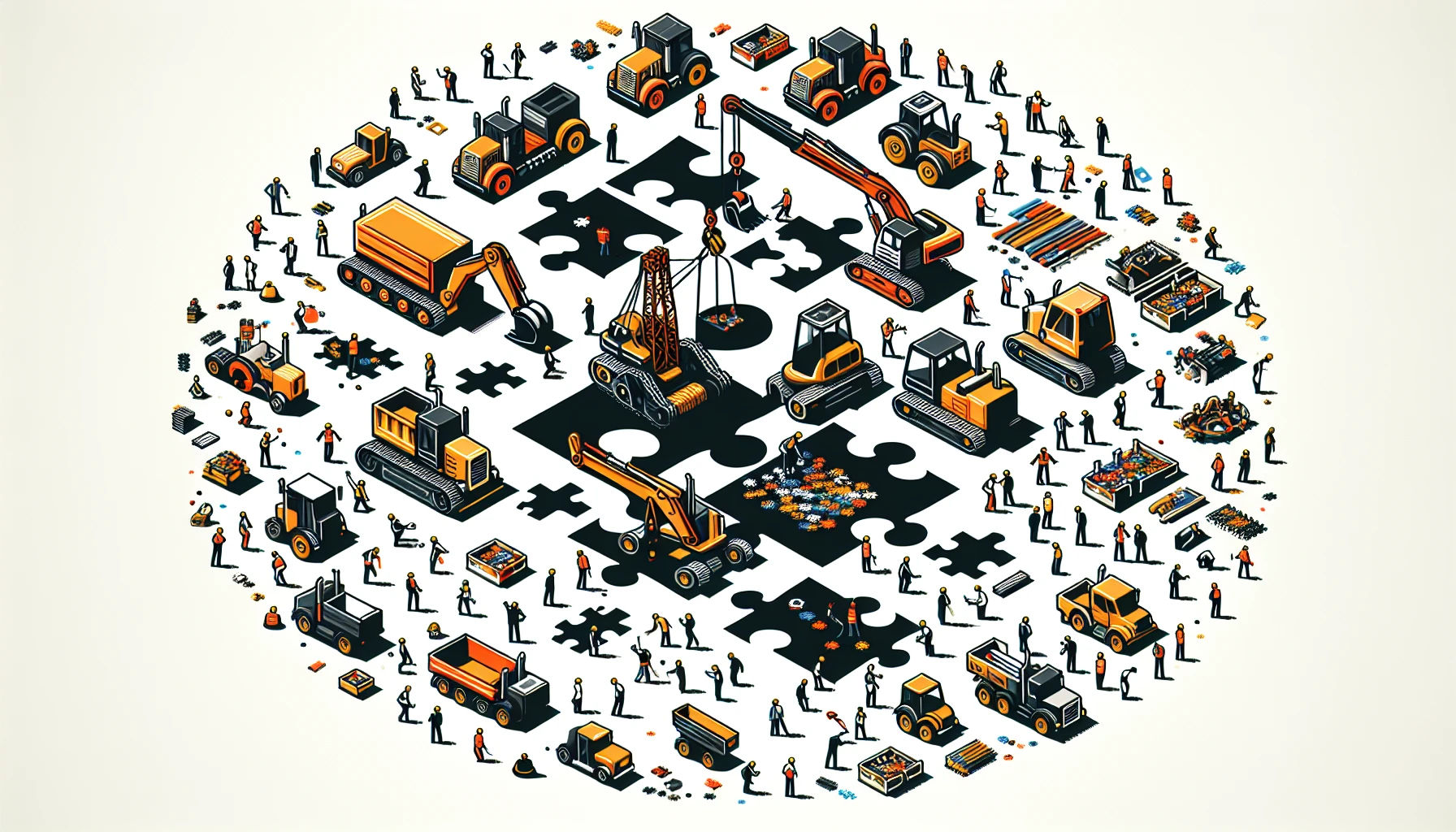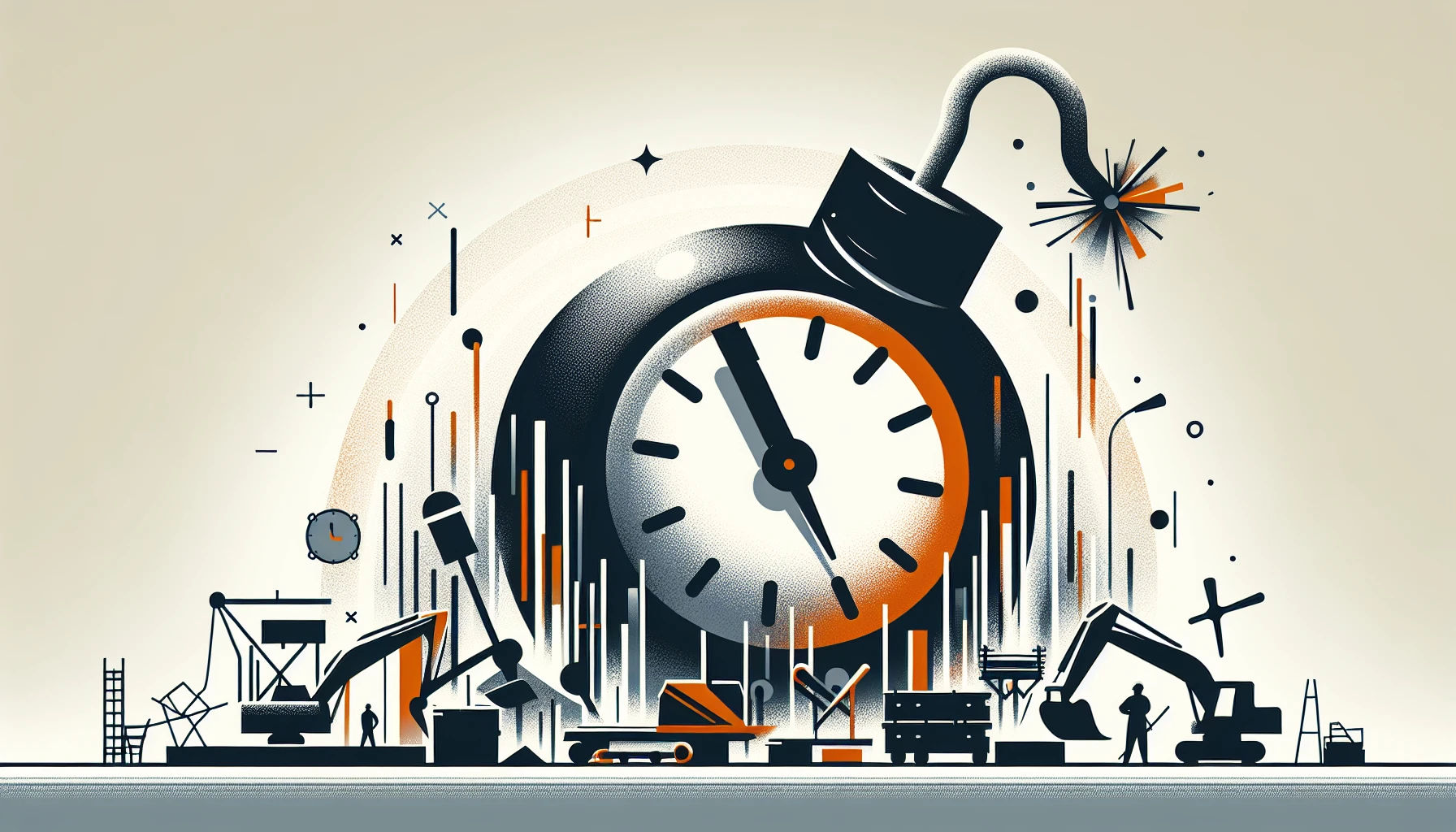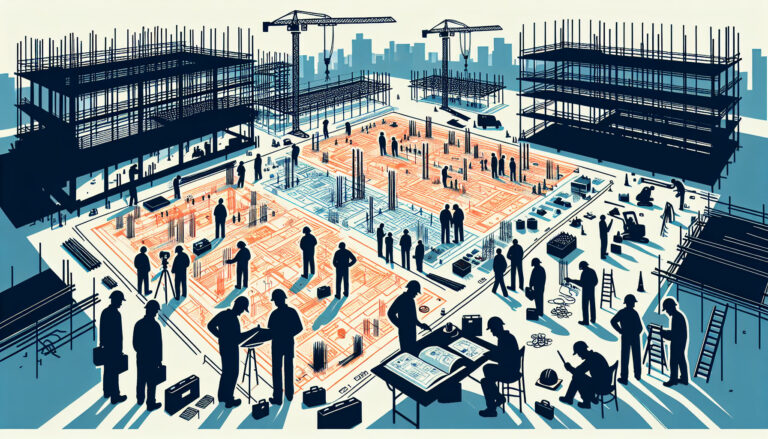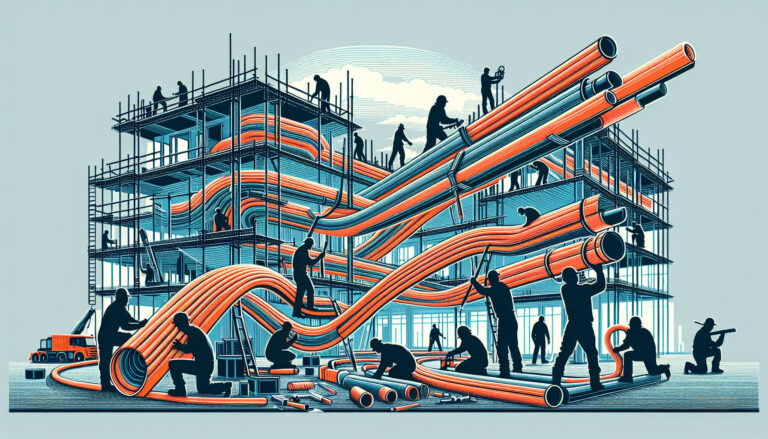Change management in construction projects is your best defense against project chaos and a critical driver for success. A small tweak can cause a massive budget or timeline mess, so mastering change management is a must.
What’s change management all about? It’s your game plan for adapting on the fly without derailing your project. Think quick pivots minus the migraines, keeping your project outcomes on target.
The average construction project sees a 5-10% increase in contract value due to change orders and mods. This isn’t just fun facts; it’s about saving your bottom line from taking a hit.
To the hard hats out there, change is your constant. It’s not just about wearing a hard hat on the jobsite; it’s about having armor for the inevitable changes. By setting up streamlined processes, you turn potential chaos into minor hiccups. Getting the hang of change management necessity means you’re already ahead in the construction game.
Change Management Best Practices in Construction
Structured workflows are your blueprint for dodging project overruns and keeping your sanity in change management in construction projects. Think GPS for navigating change—it’s not if changes will happen, but when. A robust workflow steers you clear of cost escalations and schedule setbacks, keeping your project on track.
Aligning with Project Owners
Contractor-owner alignment is crucial for smooth change implementation. It’s not a tug-of-war, but a partnership. When both parties see eye-to-eye, changes shift from conflict to collaboration.
Spotting Changes Early
Spot changes early, and you’re the early bird with the worm. Quick identification means you can tackle it head-on, stopping delays before they start. Everyone stays ready to pivot without dropping the ball.
Communication is Key
Clear, consistent communication is non-negotiable. It keeps everyone in the loop, slashing the risk of costly blunders. Stay consistent, and you’ll stay in control.
Document Every Detail
Thorough documentation is the backbone of effective change management. It’s like a diary for your project—nothing’s too small to note. It keeps everyone accountable, making it easier to track progress and make smart moves.
Remember, with top-notch change management, your project is nearly 1.5 times more likely to stay on budget. That’s not just good practice; it’s good business.
Learn more about the impact of change management on project success.
Types of Change in Construction Projects
Recognizing the types of changes in change management in construction projects is key. Different changes need different strategies.
Design Changes
Mid-project design tweaks can cause a domino effect. It’s not just drawing lines differently; it hits everything from ordering materials to scheduling workers.
Scope Changes
Scope changes mean you’re doing more or less than planned. They can bring legal headaches and require different skills. Get a handle on this to avoid the dreaded scope creep.
Schedule Changes
Timeline changes mess with everyone’s plans. Whether it’s faster or slower, it’s about keeping the team in sync and the project on track.
Cost Changes
Budget shifts mean you’ve got to stay sharp with the numbers. Flexibility with finances is crucial to keep your project from bleeding money.
Contractual Changes
Contract changes may seem boring, but they run the show. Stay on top of them to keep your project legal and on point.
Regulatory Changes
New regulations mean it’s time to check your compliance. Stay within the law to avoid fines or worse, a shutdown.
Unforeseen Changes
Then there’s the wildcard – stuff you can’t predict. Think weather woes or supply issues. Have plans ready to adapt quickly and minimize chaos.
Whether it’s design changes, scope changes, or those pesky unforeseen changes, they all add to the challenge. But with smart management, they’re just hurdles you can leap over.
Construction cost and productivity tracking tools are your best friend here. They help you see the changes coming and keep you on your feet.
Managing Change in Construction Projects
Spotting the exact causes of changes on a construction site isn’t easy, but getting a handle on them? That’s how you win at change management in construction projects.
Design Modifications
When architects get a burst of creativity or stakeholders flip their preferences, you face design modifications. These aren’t just tiny adjustments; they can flip your plans upside down. Handling shifting design requirements is about staying nimble and readjusting resources and timelines on the fly.
Unforeseen Site Conditions
Hidden surprises underground can mess up even the best-laid plans. We’re talking about unforeseen site conditions—running into unexpected bedrock or historical artifacts, for example. You’ve got to think and act fast to prevent your project from going off the rails.
Client Requests
Clients can be unpredictable, and their new demands might make you revisit your entire plan. Whether it’s a sudden whim for a different look or a new functional need, client requests have to be woven into the project without throwing everything else off balance.
Regulatory Requirements
New regulations can come out of nowhere. Keeping up with regulatory requirements means you stay in the clear legally and integrate new rules into your work without stopping dead in your tracks.
Market Conditions
And don’t forget the economy. Changes in market conditions can hit material costs, the availability of workers, and the whole feasibility of your project. Adapting to these shifts is key to keeping your project healthy and in the black.
Whether it’s due to design modifications, unforeseen site conditions, client requests, regulatory requirements, or changing market conditions, being proactive is non-negotiable. Adapting is crucial, and sometimes that means using tech to make these shifts smoother.
Steps to Manage Change in Construction
Identified the changes that could whack your project? Good. But that’s just step one. Now, you’ve got to manage those changes without them kicking your butt. Here’s how to keep your construction project from going off the rails.
Identifying Potential Changes
Spotting changes early saves you a headache later—like cost overruns and delays. Stay alert and ready to act. Just remember, only 38% of people are comfortable with change, but in construction, you’ve got to roll with the punches or get knocked out.
Evaluating the Situation
What’s the impact of a change? Is it a pebble or a boulder in your project’s shoe? An impact assessment is key. Look at schedules, budgets, resources—don’t freak out, just get planning.
Getting Approval for Change
Need to make a change? Get it signed off. It’s not about asking for a hall pass; it’s about covering your bases. Stakeholders hate surprises, especially with their money on the line.
Developing a Plan
Got the thumbs up? Time to hash out a plan. A bulletproof change implementation plan means no one’s guessing what to do when the heat’s on.
Keeping Everyone in the Loop
Communication is the grease in your project’s gears. Keep stakeholders in the know to avoid mix-ups and keep trust high. When in doubt, send an update out.
Implementing the Change
Showtime. Take that shiny plan and make it happen. This is where you prove your prep wasn’t just busy work. Be bold, thorough, and stick to the script.
Reviewing the Situation Frequently
Don’t kick back and hope for the best. Regular check-ins help you catch sneaky problems before they blow up. Stay nimble and adjust on the fly.
Conducting a Final Review
When the dust settles, do a post-mortem. What hit the mark, what flopped, and why? Learn from it. This debrief is how you win bigger next time around.
From nailing down change approvals to mapping out a plan, each step is about dodging bullets and paving the way for a smooth ride.
Leveraging Construction Technology for Change Management
Change management in construction projects doesn’t have to be a backbreaker. With the right tech, it’s a breeze. Construction technology—like software and apps—is streamlining what used to be a total headache.
By integrating timesheet apps and other digital tools, you’re not just keeping up; you’re leading the pack. These solutions turn managing changes from a cat-herding mess into a smooth operation—everyone’s in sync.
Let’s be real, change is a pain—but with modern digital tools, even the grumpiest project managers will lighten up. The perks are obvious: they save time, reduce errors, and keep your project on track.
The Digital Edge in Managing Changes
With construction technology in your corner, you’re ready for anything the job throws at you. It’s about having that digital edge that turns potential chaos into a well-oiled machine. Using these tools is not just smart, it’s a strategic move that boosts efficiency and accuracy.
Why Go Digital?
Last time you faced a curveball, was it smooth, or chaos? With digital tools, those frantic scrambles turn into easy shifts. You’ll be shocked at how you ever got by without them.
Wrapping this up: change management in construction projects is tough, but technology makes it a whole lot easier. It’s about working smarter, not harder. And when the crew sees how much easier their day is with these tools, they’ll jump on board—no arm-twisting necessary.
The Cost of Poor Change Management
Poor change management in construction projects? That’s like ignoring a ticking bomb. When it blows, say goodbye to your budget and schedule.
Think about it: failed change management is a direct hit to your wallet. A McKinsey study shows a whopping 70% of transformation efforts tank because people can’t handle change. That’s not just bad; it’s a disaster.
Impact on Budget and Schedule
The biggest victims here are your budget and schedule. Mismanaged changes? They’ll bleed your project dry, causing cost overruns and project delays. In the construction world, wasted time is wasted money.
- Budget Impact: Every mishandled change is another hit to your profits.
- Schedule Impact: One delay leads to another, knocking your entire timeline off track.
Productivity Losses
It’s not just about time and money. Productivity losses sneak in when your team’s rhythm is thrown off by poor change management. It’s confusing, it’s frustrating, and it’s costing you more than just morale.
Bottom line: When your crew is putting out fires instead of building, you’re just burning cash. Solid change management keeps your project afloat, financially and schedule-wise. Plus, tools like SmartBarrel’s Construction Manpower Tracking can help you keep a grip on your workforce during the chaos of change.
Change Management Culture
Forget slow and steady, let’s talk culture. In the construction chaos, a change management culture isn’t just nice, it’s your lifeline. Think of it as prepping your crew for a storm that’s guaranteed to hit, because it will. This isn’t about surviving; it’s adapting fast to thrive.
Building a Change Culture
Laying down a change culture is like pouring concrete – do it right, and it sets the stage for everything else. Make sure everyone gets it: change is as sure as rain in April. It’s not a beast to fear but a friend that helps you level up.
- Set solid change expectations
- Train your people, so they’re not blindsided by change
Change Order Policy
Now, for the practical stuff. A tight change order policy is your defense against chaos. It’s the game plan for handling curveballs without losing your cool. A sharp policy sets the rules, dishes out roles, and keeps you on track, dodging budget busters and scope creep like a pro.
- Build a bulletproof change order policy
- Stick to it, no matter the project
Wrapping up, a solid change management culture isn’t optional. It’s the armor you wear into the battle of construction. And hey, tools like SmartBarrel’s Construction Safety Tracking are like having a secret weapon that slots right into your battle plan, keeping you sharp and ahead of the game.
Tailoring Change Management to Project Complexity
Different construction projects need different strategies—plain and simple. Change management customization means shaping your approach to snugly fit your project’s size and complexity.
Using a generic strategy for change management in construction projects is a no-go. It’s all about creating a perfect fit for each project, whether it’s a quick fix or a massive build.
Customization for Different Projects
Every project is unique, with its own set of challenges. You’ve got to be agile with your change management, customizing it to each project’s specific needs.
- Smaller projects might just need simple, adaptable methods.
- Big projects demand more structured, in-depth approaches.
- Understanding the nitty-gritty of complexity management is key.
Stuck in a complex situation? Tools like SmartBarrel’s AI-powered, biometric time clocks can make workforce management less of a headache, smoothing out the change management in construction projects process. Pairing these tools with strategies that fit just right guarantees compliance without messing with the workflow.
So here’s the deal: tailoring strategies isn’t about showing off; it’s about precision—nailing it every single time. Whether it’s adjusting to project size or mastering the dance of complexity management, the goal is always to keep your project moving smoothly without any fuss.
Change Management: The Blueprint for Construction Project Success
You get it—change management in construction projects is about being proactive and agile. It’s not about fearing change; it’s about steering through it like a boss. Embrace it, and you’ll transform potential havoc into your project’s success story.
- Embrace structured workflows and streamlined processes
- Develop strong communication channels for early identification and prompt notification of changes
- Ensure thorough documentation and consistent application of change order policies
- Leverage technology like SmartBarrel’s solutions to track costs, productivity, and manpower efficiently
Changes are going to happen. Be ready for them, and you could turn a headache into an advantage. Tackle design alterations, scope expansions, and market shifts with a game plan that includes cutting-edge tech to boost your efficiency.
Change is constant, but so is your capacity to manage it.
Let’s be clear: change management is a must-do for nailing construction projects. Get your team’s head in the game, stick to solid change policies, and throw in some top-notch tools like SmartBarrel. You’ll see your team’s motivation skyrocket, productivity shoot up, and projects cross the finish line on time.
So, what’s the end game? To kick butt in the unpredictable world of construction, not just get by. Master change management, and you’ll protect your budgets, timelines, and sanity. If you’re pumped to get a grip on change in your projects, scope out SmartBarrel. They’ve got the gear to turn your challenges into wins.















